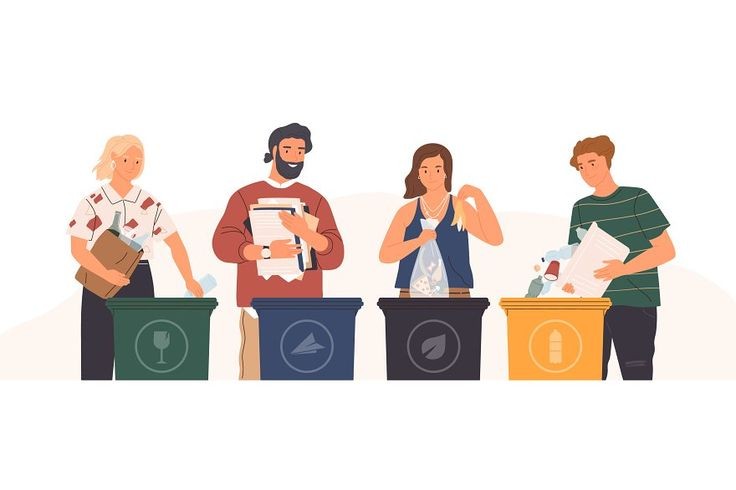The sorting of waste is critical to increasing the amount of waste that is recycled, as well as the quality of recycled materials. From individual household input to huge commercial waste loads, everyone has a role to play in effectively sorting waste. The waste sorting process is where waste is sorted into categories, according to material or recyclability.
Waste sorting happens at many levels of society and sizes, from the general public using different bins for different waste types, to businesses separating recyclable materials.
The type of waste sorted at a particular place depends on a variety of factors; for example, construction waste may be sorted at a general MRF (materials recovery facility), whereas metal waste may be sorted in a specialized facility.
Generally, waste is sorted according to material, recyclability, or any particular process required. Sorted waste includes paper, cardboard, glass, plastic, wood, scrap metal, compost, hazardous waste, residual waste, and more.
Organic waste is often also collected and sorted i.e. food waste. This includes peelings, tea bags, eggshells, and coffee grounds for composting.
Types of Waste
They can be separated into two categories. Both need to be disposed of and recycled differently. Remember that wet waste is organic and dry is not.
Wet waste includes cooked and uncooked food, waste from fruits and flowers, fallen leaves, dust from sweeping, and other similar things. It consists of kitchen waste – including vegetable and fruit peels and pieces, tea leaves, coffee grounds, eggshells, bones and entrails, fish scales, as well as cooked food (both veg and non-veg).
Dry waste includes cloth rags, glass, leather, metals, paper, plastic, rubber, wire, related things, etc. – anything that can be kept for an extended period without decomposing.
Also, there are some more types of wastes like:
- E-waste or electronic waste consists of batteries, computer parts, wires, electrical equipment of any kind, electrical and electronic toys, remotes, watches, cellphones, as well as bulbs, tube lights, and CFLs.
- Biomedical waste includes used menstrual clothes, sanitary napkins, disposable diapers, bandages, and any material that is contaminated with blood or other body fluids.
- HHW or household hazardous wastes include three sub-categories – E-waste; toxic substances such as paints, cleaning agents, solvents, insecticides, and their containers, other chemicals; and biomedical wastes like used syringes, expired medicines, thermometers, used cosmetics, etc.
- Garden waste will be collected by the BBMP on specified days or can be dropped off at the nearest specified park for composting. Leaves can be composted in your house itself.
Waste Sorting Process
Beginning with the individual separating waste types, and ending with the disposal or recycling of materials, the waste sorting process is critical to effective and efficient recycling. Although varying, here is the waste sorting process that occurs at an MRF using in-house collection vehicles:
- Waste enters MRF – Whether the waste is brought to an MRF by the general public or collection vehicles, waste loads are weighed and recorded to track waste transfer. For businesses, this stage is key to recording waste management as well as recycling. Waste may also enter MRFs in skips, hired out by the company.
- Waste emptied – Waste is emptied onto conveyer belts ready to be sorted. There is usually a pre-sort area where non-recyclable materials are removed.
- Waste sorted – Depending on the materials and amounts, the processes of sorting vary. There are advanced technologies developed for waste sorting, however, certain stages may be performed manually too. From trommels and ballistic separators to sort glass and paper, to scanners and magnets for metal sorting, MRFs are well equipped for a variety of waste types.
- Waste processed – Once sorted into types, waste will be subject to quality checks to monitor impurities. Certain materials may be sorted further, for example separating different grades of paper or cardboard.
- Waste prepared for shipment – Before leaving the MRF or being further processed for recycling, materials will be prepared for shipment. This may involve baling, shredding, crushing, compacting, etc. to keep the sorted material together and space-efficient while moving.
- Waste repurposed – Where possible, materials are reused, repurposed, and recycled. By implementing the Waste Hierarchy and exploring other disposal methods, waste processors aim to divert waste from landfills.
How can you contribute to more sustainable waste management?
Firstly, you should try to produce less waste. You can do this by taking a cloth bag with you when you go shopping so that you don’t have to pack fruit and vegetables in plastic bags. Or you can shop at the market more often. Not only are fruits and vegetables guaranteed to be unpackaged, but they are also produced locally. This saves valuable resources used during transportation and aids in protecting the environment.
If you can’t avoid packaging materials, you need to separate them correctly so that recyclable materials can be sorted completely later. Take care, for example, to separate the lid on yogurt pots and remove the paper coating. The lid and cup then belong in the yellow bin or the yellow bag, and the wrapping is disposed of in the paper bin. This is important so that the aluminum lid can be separated from the plastic cup in the sorting plant and the raw materials can be recycled accordingly instead of ending up in the incinerator.
It is best to find out directly from your district which separation system they use to ensure the correct disposal of the waste.
How to separate your household waste:
Throwing waste in the bin is a good habit. However, it is not where the process of managing waste ends, but where it begins. Segregation is the first step of waste management. While most of us think that it starts once the waste reaches the dustbin
vans or the dumping grounds, it starts right at our house.
For practicing waste management at home you should keep separate containers for dry and wet waste in the kitchen, keep two bags for dry waste collection- paper and plastic, for the rest of the household waste, keep plastic from the kitchen clean and dry and drop into the dry waste bin, keep glass /plastic containers rinsed of food matter, send wet waste out of the home daily, store, and send dry waste out of the home, once a week, and keep a paper bag for throwing the sanitary waste.
For recycling old clothes/ shoes/ handbags/belts/toys, if they are still in usable condition, they should be given to some organization that collects them. If they are totally unusable or much damaged, they are still categorized as dry waste.
If clothes are soiled with body fluids, they become sanitary waste. If they are soiled with paint or any chemicals, they are HHW (household hazardous waste).
For old furniture, they can be recycled, if not, along with broken glass it can be disposed of as debris or rubbish (inerts).
If old crockery / non-stick pans are not broken, they are recyclable dry waste. If broken, debris or rubbish (inerts).
Here are 4 ways to segregate waste in apartments
1) Wet/Kitchen Waste
This comprises items like fruit peels, leftovers, vegetable skins, uncooked food, coffee or tea powder, and garden waste like leaves and twigs.
Maintain a drum, container, or bin to deposit such waste, so that it can be converted into rich organic compost. You can choose your composting process. Examples include vermicomposting, aerobic, and anaerobic composting.
2) Dry waste
Dry waste is divided into recyclable and non-recyclable waste. Items like used paper towels, hazardous chemical or food containers, foam materials, and dishware are some examples of dry waste that cannot be recycled or reused.
Dry recyclable waste includes pet bottles, plastic carry bags, newspapers, glass bottles, shoes, plastic cutlery, tires, cardboard, and so on.
If the recyclable waste is segregated further, it can fetch you money or goodies. Since dry waste only consists of 30-40% of the total household waste, maintain a recyclable bin and give it away every once or twice a week.
3) Sanitary Waste
Diapers (adults and babies), synthetic sanitary napkins, hygiene-related products, condoms, tampons, soiled napkins are classified as sanitary waste. The medical waste consists of linens, bedding, items contaminated with blood or body fluids, soiled plaster casts, and other types of dressing.
Medical and sanitary waste has to be incinerated, microwaved, or autoclaved to avoid the spread of diseases.
Since not every city or village in India is equipped with facilities to treat the waste scientifically, the best way to dispose of them is to wrap it in a newspaper and mark it with a red dot for easy identification.
4) E-waste
There are three types of electronic waste you must be aware of:
- Bulky: Fridge, microwave, or anything is that is difficult to carry around.
- Hazardous: Tube lights, light bulbs, toner cartridges, batteries, monitors, and screens. Anything with a chemical component.
- Non-hazardous: Cables, chargers, microwaves, gadgets like laptops and phones.
- Collect all the e-waste in a container, and you can follow a weekly, monthly, or yearly disposal process.
- Just like dry waste, there are several public e-waste drop-off points, online collection services, recycling centers where you can donate or trade your electronic waste.
How to segregate waste at work:
Most of the offices follow a two-bin system—one for recyclable waste and one for wet garbage. But just like your home, the more you segregate, the better the waste management.
Here are four bins that every office should have:
- A bin for wet waste like leftover food, vegetable or fruit peels, tea bags, etc. in the canteen or cafeteria. If the volume of wet waste is vast, an office can also follow on-site composting.
- Dry waste should be further divided into plastic, metal, glass, and paper. Send each type of garbage every week to recycling centers or services.
- Electronic waste like CDs, pen drives, bulbs, tube-lights, computer systems, electric cables, keyboards, batteries, motherboards, etc. should be collected by the office and transported to e-waste collection centers.
- Bins should be placed in bathrooms for sanitary waste like pads. Some offices even install incinerators to treat it at the source.
Waste segregation means keeping wet and dry wastes separately, so that dry can be recycled and wet waste can be composted:
- So that it reduces waste that reaches landfills and reduces pollution to air and water
- So that different processes- composting, recycling, incineration can be applied to different kinds of waste
As a result, first, we should try lesson waste consumption and second separate our garbage based on being wet or dry.

